杜洪波卷四讲义
- 格式:docx
- 大小:29.93 KB
- 文档页数:3
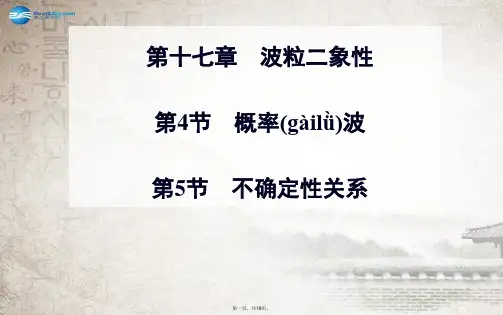
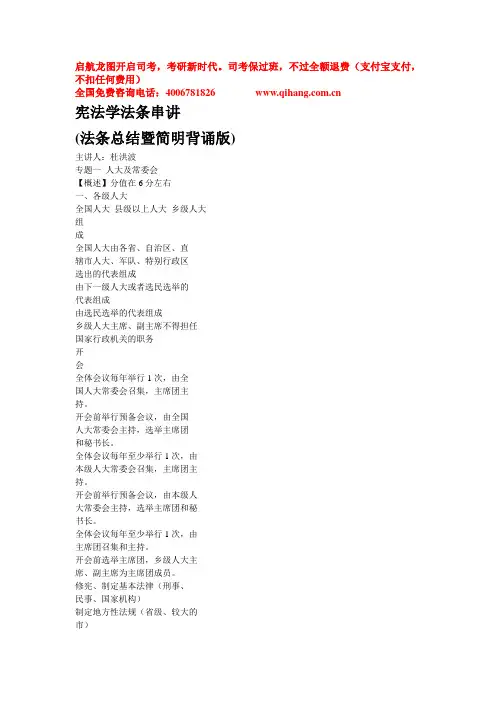
启航龙图开启司考,考研新时代。
司考保过班,不过全额退费(支付宝支付,不扣任何费用)全国免费咨询电话:4006781826 宪法学法条串讲(法条总结暨简明背诵版)主讲人:杜洪波专题一人大及常委会【概述】分值在6分左右一、各级人大全国人大县级以上人大乡级人大组成全国人大由各省、自治区、直辖市人大、军队、特别行政区选出的代表组成由下一级人大或者选民选举的代表组成由选民选举的代表组成乡级人大主席、副主席不得担任国家行政机关的职务开会全体会议每年举行1次,由全国人大常委会召集,主席团主持。
开会前举行预备会议,由全国人大常委会主持,选举主席团和秘书长。
全体会议每年至少举行1次,由本级人大常委会召集,主席团主持。
开会前举行预备会议,由本级人大常委会主持,选举主席团和秘书长。
全体会议每年至少举行1次,由主席团召集和主持。
开会前选举主席团,乡级人大主席、副主席为主席团成员。
修宪、制定基本法律(刑事、民事、国家机构)制定地方性法规(省级、较大的市)选举权:选举国家主席、副主席、中央军委主席、最高法院院长、最高检察院检察长、全国人大常委会的组成人员选举本级政府正副职首长、本级法院院长、本级检察院检察长、本级人大常委会组成人员选举本级政府正副职首长、乡级人大主席、副主席决定权:①根据国家主席的提名,决定国务院总理的人选;②根据国务院总理的提名,决定国务院其他组成人员的人选;③根据中央军委主席的提名,决定中央军委其他组成人员的人选;罢免权:主席团、3个以上代表团、1/10以上的代表提出对上述选举和决定人员的罢免案。
主席团、常委会、1/10以上的代表提出对上述选举人员和本级政府其他组成人员的罢免案。
主席团、1/5以上的代表提出对上述选举人员的罢免案职权监督权:监督全国人大常委会、一府两院对其负责并报告工作,中央军委主席对其负责。
监督本级人大常委会、一府两院对其负责并报告工作监督本级政府对其负责并报告工作工作制议案:①一府两院三委一团;②1个代表团或者30名以上代表①一府两委一团②10个代表以上①一府一团②5个代表以上质询案:1个代表团或者30名以上的代表,可以提出对一府两院的质询案10代表以上提出对一府两院的质询案10个代表以上提出对一府的质询案二、人大常委会全国人大常委会地方各级人大常委会(乡级没有)组成委员长、副委员长、秘书长、委员常委会组成人员不得担任国家行政机关、审判机关和检察机关的职务。
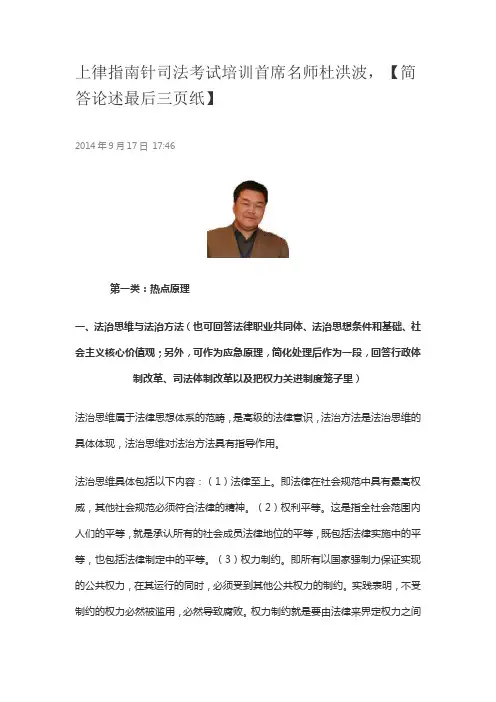
上律指南针司法考试培训首席名师杜洪波,【简答论述最后三页纸】2014年9月17日17:46第一类:热点原理一、法治思维与法治方法(也可回答法律职业共同体、法治思想条件和基础、社会主义核心价值观;另外,可作为应急原理,简化处理后作为一段,回答行政体制改革、司法体制改革以及把权力关进制度笼子里)法治思维属于法律思想体系的范畴,是高级的法律意识,法治方法是法治思维的具体体现,法治思维对法治方法具有指导作用。
法治思维具体包括以下内容:(1)法律至上。
即法律在社会规范中具有最高权威,其他社会规范必须符合法律的精神。
(2)权利平等。
这是指全社会范围内人们的平等,就是承认所有的社会成员法律地位的平等,既包括法律实施中的平等,也包括法律制定中的平等。
(3)权力制约。
即所有以国家强制力保证实现的公共权力,在其运行的同时,必须受到其他公共权力的制约。
实践表明,不受制约的权力必然被滥用,必然导致腐败。
权力制约就是要由法律来界定权力之间的关系,使权力服从法律。
(4)权利本位。
即相对于国家权力而言,人民权利是决定性的;相对于法律义务而言,法律权利是本位。
二、法治社会、法治国家、法治政府的关系首先,社会是法律的前提与基础。
在这个意义上,法治社会是法治国家与法治政府建设的前提与基础。
建设法治社会,核心要求在于实现私权利行使的合法性,推进全民守法。
卢梭曾说:“真正的法律……铭刻在公民的内心里”,全民守法为法治中国建设提供了坚实的社会基础。
其次,现代法治的精义是控制公权力。
建设法治政府,首要措施就是要实现公权力运行的法治化。
具体包括:(1)严格执法。
行政权力的行使必须以合法性为前提,实现行政合法性与合理性的协调。
(2)公正司法。
推进司法公开,实现司法公正,真正树立司法权威。
最后,法治国家是法治中国的整体要求,对法治社会和法治政府建设提供了总体的指导。
具体包括:(1)坚持法律至上,排斥人治;(2)权利保障为本位,倡导权利保障的优先性;(3)完善法律监督,实现国家监督与社会监督的协调发展【本段为灵活段】需要指出的是,建设法治中国,必须坚持党的领导,坚持执政党对法治社会、法治国家、法治政府建设的统领作用。

2010年法理学讲义精编主讲人:洪 波专题一 法的概念、本质、特征和作用 争议焦点 法与道德之间是否具有本质的、必然的联系权威制定是法概念的首要要素——分析法学派:哈特、奥斯丁等; 社会实效是法概念的首要要素——社会法学派 实证:无必然联系权威制定、社会实效均是法概念的必要要素 内容正确性是法的唯一定义要素——自然法学派 立场类型非实证:必然联系第三条道路:内容正确性+权威性制定+社会实效——阿里克西 1.实证主义在功能和内容上并不绝对排斥道德,只是认为,道德不是必要要素。
概念 【考点分析】 2.非实证主义也并不排斥政治、社会对法律影响,只是认为,道德是必要要素。
形成方式:国家制定或者认可 实施方式:国家强制力保证实施 国家性 (正式性 官方性) 国家制定或认可,并由国家强制力保证实施的正式的官方的确定的行为规范;法直接形成于国家权力,是国家意志的体现 表现形式:国家发布的官方文件的规范性表现不是个别意志简单相加,表面具有公共性和中立性法律化的统治阶级意志,但也考虑被统治阶级的某些利益或要求阶级性统治阶级意志体现 具有高度的统一性和极大的权威性 法的内容受一定社会因素制约;其中,最终由一定社会的物质生活条件决定社会性 “国家不是在创造法律,而是在表述法律”1.法的本质在正式性、阶级性和社会性的关系中来理解;但最终决定作用是物质生活条件本质 【考点分析】2.法中也包含被统治阶级的利益和要求;但不是被统治阶级意志的体现 同道德等一样,都是社会规范,都有强制力(法:国家强制力) 与自然法则不同,法律是文化现象,调整人与人之间的关系 规范性 调整人的行为的社会规范 调整对象是“参加社会关系的人的行为”制定 立法 明示认可:某种规范直接法律化 国家意志性 由公共权力机构制定或认可的具有特定形式的社会规范 认可 默示认可:“依照习惯、依照国家政策”等普遍有效性:在国家权力所及的范围内,法具有普遍效力普遍平等对待性:法律面前人人平等普遍性 普遍一致性:法的内容始终与人类的普遍要求相一致任何规范都有保证实施的强制力法的强制力是国家强制力国家强制性 国家强制力本身也要依法行使可争讼性:可以用来作为起诉、辩护的根据 可诉性可裁判性:可以用来作为法院适用的标准特征 权利义务性 法以权利义务为内容,从而规定不同的行为模式。
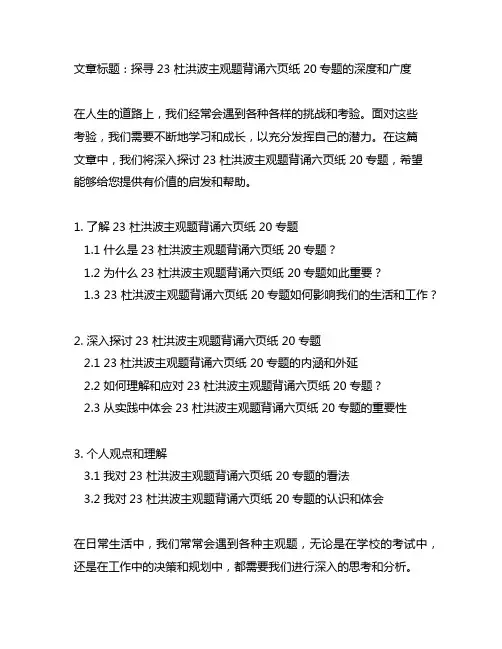
文章标题:探寻23 杜洪波主观题背诵六页纸 20专题的深度和广度在人生的道路上,我们经常会遇到各种各样的挑战和考验。
面对这些考验,我们需要不断地学习和成长,以充分发挥自己的潜力。
在这篇文章中,我们将深入探讨23 杜洪波主观题背诵六页纸 20专题,希望能够给您提供有价值的启发和帮助。
1. 了解23 杜洪波主观题背诵六页纸 20专题1.1 什么是23 杜洪波主观题背诵六页纸 20专题?1.2 为什么23 杜洪波主观题背诵六页纸 20专题如此重要?1.3 23 杜洪波主观题背诵六页纸 20专题如何影响我们的生活和工作?2. 深入探讨23 杜洪波主观题背诵六页纸 20专题2.1 23 杜洪波主观题背诵六页纸 20专题的内涵和外延2.2 如何理解和应对23 杜洪波主观题背诵六页纸 20专题?2.3 从实践中体会23 杜洪波主观题背诵六页纸 20专题的重要性3. 个人观点和理解3.1 我对23 杜洪波主观题背诵六页纸 20专题的看法3.2 我对23 杜洪波主观题背诵六页纸 20专题的认识和体会在日常生活中,我们常常会遇到各种主观题,无论是在学校的考试中,还是在工作中的决策和规划中,都需要我们进行深入的思考和分析。
而23 杜洪波主观题背诵六页纸 20专题,正是对这一能力的锻炼和提升。
通过对这一专题的深入探讨和理解,我们可以更好地应对各种挑战和考验,成为更加出色的自己。
总结回顾,23 杜洪波主观题背诵六页纸 20专题无疑是一个重要而深刻的主题,它涵盖了丰富的内涵和外延,在我们的日常生活和工作中具有重要的意义。
通过深入挖掘和理解这一专题,我们可以更好地应对各种问题和挑战,成为真正的智者和领袖。
在撰写本文的过程中,我深刻体会到了23 杜洪波主观题背诵六页纸20专题的重要性和价值。
我深信,只有通过不断地学习和思考,我们才能不断地成长和进步,成为自己想要成为的人。
以上就是本文对23 杜洪波主观题背诵六页纸 20专题的深度和广度的探讨,希望能够给您带来一些启发和帮助。
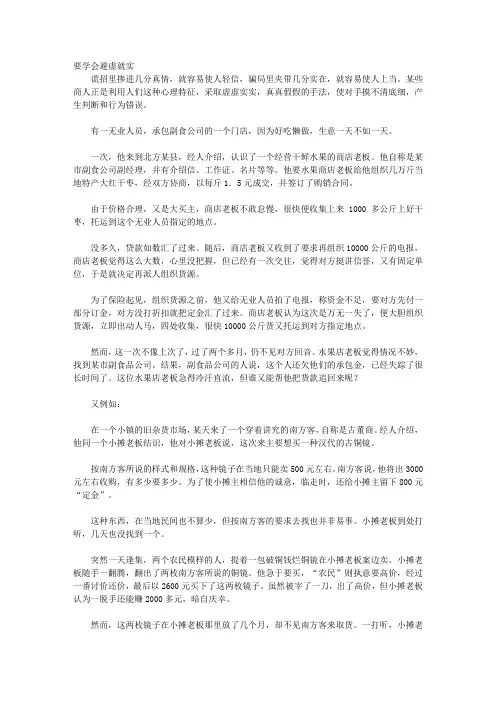
要学会避虚就实谎招里掺进几分真情,就容易使人轻信,骗局里夹带几分实在,就容易使人上当。
某些商人正是利用人们这种心理特征,采取虚虚实实,真真假假的手法,使对手摸不清底细,产生判断和行为错误。
有一无业人员,承包副食公司的一个门店,因为好吃懒做,生意一天不如一天。
一次,他来到北方某县,经人介绍,认识了一个经营干鲜水果的商店老板。
他自称是某市副食公司副经理,并有介绍信、工作证、名片等等。
他要水果商店老板给他组织几万斤当地特产大红干枣,经双方协商,以每斤1.5元成交,并签订了购销合同。
由于价格合理,又是大买主,商店老板不敢怠慢,很快便收集上来1000多公斤上好干枣,托运到这个无业人员指定的地点。
没多久,贷款如数汇了过来。
随后,商店老板又收到了要求再组织10000公斤的电报,商店老板觉得这么大数,心里没把握,但已经有一次交往,觉得对方挺讲信誉,又有固定单位,于是就决定再派人组织货源。
为了保险起见,组织货源之前,他又给无业人员拍了电报,称资金不足,要对方先付一部分订金,对方没打折扣就把定金汇了过来。
商店老板认为这次是万无一失了,便大胆组织货源,立即出动人马,四处收集,很快10000公斤货又托运到对方指定地点。
然而,这一次不像上次了,过了两个多月,仍不见对方回音。
水果店老板觉得情况不妙,找到某市副食品公司。
结果,副食品公司的人说,这个人还欠他们的承包金,已经失踪了很长时间了。
这位水果店老板急得冷汗直流,但谁又能帮他把货款追回来呢?又例如:在一个小镇的旧杂货市场,某天来了一个穿着讲究的南方客,自称是古董商。
经人介绍,他同一个小摊老板结识,他对小摊老板说,这次来主要想买一种汉代的古铜镜。
按南方客所说的样式和规格,这种镜子在当地只能卖500元左右。
南方客说,他将出3000元左右收购,有多少要多少。
为了使小摊主相信他的诚意,临走时,还给小摊主留下800元“定金”。
这种东西,在当地民间也不算少,但按南方客的要求去找也并非易事。
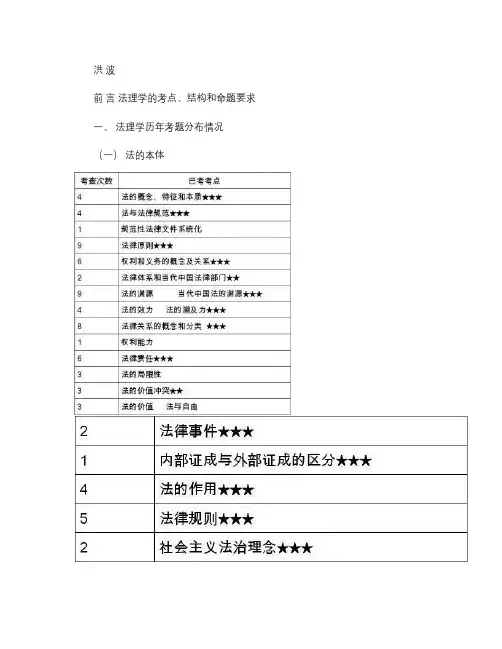
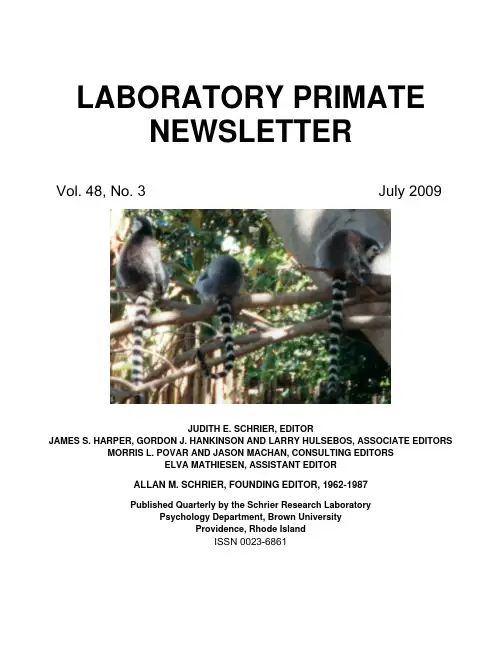
LABORATORY PRIMATENEWSLETTERVol. 48, No. 3Ju ly 2009JUDITH E. SCHRIER, EDITORJAMES S. HARPER, GORDON J. HANKINSON AND LARRY HULSEBOS, ASSOCIATE EDITORS MORRIS L. POVAR AND JASON MACHAN, CONSULTING EDITORSELVA MATHIESEN, ASSISTANT EDITORALLAN M. SCHRIER, FOUNDING EDITOR, 1962-1987Published Quarterly by the Schrier Research LaboratoryPsychology Department, Brown UniversityProvidence, Rhode IslandISSN 0023-6861POLICY STATEMENTThe Laboratory Primate Newsletter provides a central source of information about nonhuman primates and related matters to scientists who use these animals in their research and those whose work supports such research. The Newsletter (1) provides information on care and breeding of nonhuman primates for laboratory research, (2) disseminates general information and news about the world of primate research (such as announcements of meetings, research projects, sources of information, nomenclature changes), (3) helps meet the special research needs of individual investigators by publishing requests for research material or for information related to specific research problems, and (4) serves the cause of conservation of nonhuman primates by publishing information on that topic. As a rule, research articles or summaries accepted for the Newsletter have some practical implications or provide general information likely to be of interest to investigators in a variety of areas of primate research. However, special consideration will be given to articles containing data on primates not conveniently publishable elsewhere. General descriptions of current research projects on primates will also be welcome.The Newsletter appears quarterly and is intended primarily for persons doing research with nonhuman primates. Back issues may be purchased for $10.00 each. We are no longer printing paper issues, except those we will send to subscribers who have paid in advance. We will not accept future subscriptions, unless subscribers are willing to pay $100/year. (Please make checks payable to the Brown University Psychology Department.) Readers with access to electronic mail may receive a notice when a new issue is put on the Website by sending the message subscribe LPN-WARN your-own-name to listserv@.(Send the message subscribe LPN-PDF to receive PDF files by e-mail; or the message subscribe LPN-L to receive the nongraphic contents of each issue.) Current and back issues of the Newsletter are available on the World Wide Web at </primate>. Persons who have absolutely no access to the Web, or to the electronic mailing, may ask to have paper copies sent to them.The publication lag is typically no longer than the three months between issues and can be as short as a few weeks. The deadline for inclusion of a note or article in any given issue of the Newsletter has in practice been somewhat flexible, but is technically the tenth of December, March, June, or September, depending on which issue is scheduled to appear next. Reprints will not be supplied under any circumstances, but authors may reproduce their own articles in any quantity.PREPARATION OF ARTICLES FOR THE NEWSLETTER. – Articles, notes, and announcements may be submitted by mail, e-mail, or computer disk, but a printed copy of manuscripts of any length or complexity should also be sent by regular mail.. Articles in the References section should be referred to in the text by author(s) and date of publication, e.g., Smith (1960) or (Smith & Jones, 1962). Names of journals should be spelled out completely in the References section. Latin names of primates should be indicated at least once in each note and article. In general, to avoid inconsistencies within the Newsletter, the Latin names used will be those in Mammal Species of The World: A Taxonomic and Geographic Reference, 2nd Ed. D. E. Wilson & D. M. Reeder (Eds.). Washington, DC: Smithsonian Institution Press, 1993. For an introduction to and review of primate nomenclature see The Pictorial Guide to the Living Primates, by N. Rowe, Pogonias Press, 1996.All correspondence concerning the Newsletter should be addressed to:Judith E. Schrier, Psychology Department, Box 1853, Brown UniversityProvidence, Rhode Island 02912 [401-863-2511; FAX: 401-863-1300]e-mail address: primate@Current and back issues of the Newsletter are available on the World Wide Web at/primateACKNOWLEDGMENTSThe Newsletter is supported by Brown University.Cover photograph of ring-tailed lemurs (Lemur catta),taken at the San Diego Zoo by Paul Wilde, 1997Copyright © 2009 by Brown UniversityThe Effects of Exposure to an Expanded Environmental Enrichment Program onSelect Individual Behaviors in BaboonsAmy K. Goodwin, Susan A. James, Kelly E. Lane, Michael C. McDermott, Rebecca L. Rodgerson, and Nancy A. Ator Johns Hopkins University School of Medicine, Department of Psychiatry and Behavioral Sciences, Division of BehavioralBiologyIn our laboratory, we had often discussed our desire to create an area in which our singly housed, adult male ba-boons could be released to exercise. The opportunity to do so arose when an environmental enrichment grant from the Center for Alternatives to Animal Testing at Johns Hopkins University provided funding for such a project. Thus, the goals of the present study were to cre-ate an area large enough for baboons to safely engage in species-specific behavior (i.e., free movement, explora-tory behavior, foraging) and to learn whether exposure to this environment would be correlated with changes in target behaviors considered indicators of psychological well-being.MethodsSubjects: Six adult male baboons (Papio anubis; Primate Imports, New York, NY, or Southwest Foundation for Biomedical Research, San Antonio, TX) served as sub-jects in the present study. The six baboons (BB, DC, SY, CY, DE and SC) had been in the laboratory for at least three years and had been subjects in behavioral pharma-cology studies. During the present study, the behavioral pharmacology studies in which they participated included acute exposure to psychoactive compounds. Subjects were individually housed in stainless steel primate cages equipped with a bench running along one cage wall. The home cages, which provided 10 square feet of floor space (46.5 cubic feet total space), also served as the experi-mental chambers, so the behavioral pharmacology ex-periments took place in the home cage. Such experiments typically involve the use of one or more levers, stimulus lights, tones, and food pellet delivery. The baboons had visual and auditory access to other baboons.The baboons had continuous access to tap water from a spout at the front of their cages and received a daily ration of Lab Diet (®PMI Nutrition International) or Pri-mate diet (®Harlan Teklad) biscuits, one or two pieces of Amy K. Goodwin, Johns Hopkins Univ. Sch. of Med., Behav-ioral Biology Research Center, 5510 Nathan Shock Dr., Suite 3000, Baltimore, MD 21224 [410-550-2781; fax: 410-550-2780; e-mail: Goodwin@].The establishment of the enrichment room was made possi-ble through an Animal Welfare Enhancement Award made by the Johns Hopkins University Center for Alternatives to Animal Testing. The authors would also like to thank Dan Rodgerson for the technical expertise he lent to the project, and Robert J. Adams, DVM, for helpful comments during the protocol review process and manuscript preparation.fresh fruits or vegetables daily, and children’s chewable multivitamins. Daily feeding occurred in late morning (never prior to time spent in the enrichment room). The enrichment program already established in the colony, which included human interaction, access to three or more toys (forage boxes, puzzle feeders, mirrors, Kong® toys, wood logs), and music continued without change during the present study.The overhead lights in the housing room were on for 13 h/day (6:00-19:00 h) and off for the remaining 11 h/day. Natural light also illuminated the room.Routine physical examinations (under ketamine hy-drochloride anesthesia) occurred every two weeks or ap-proximately once per month, depending on the study in which each subject was serving.All protocols were approved by the Johns Hopkins University Animal Care and Use Committee. Animal care and use and facility maintenance followed the Guide for the Care and Use of Laboratory Animals (1996) and the U. S. Animal Welfare Regulations. Johns Hopkins University is accredited by the Association for Assess-ment and Accreditation of Laboratory Animal Care Inter-national.Room Construction: It was vital that the time and effort required to create the enrichment room space be manage-able and that the expense stay below the $6000 received for the project from the Animal Welfare Enhancement Award. Ultimately, by using resources already available to us, we were able to manage the time and effort required without affecting the normal daily functioning in the labo-ratory.The space designated for the enrichment room had been constructed as an animal housing room (i.e., wall and floor surfaces met Guide standards; air was vented externally), and all environmental aspects (e.g., tempera-ture and humidity) were controllable by laboratory per-sonnel. The space was not needed for housing animals when the project began. The room has 145.8 square feet of floor space (663.5 cubic feet of total space), a fully functional sink, and a steel railing on three walls.A door had to be constructed such that baboons would be able to be safely transferred in and out of the room using the shuttle system described below. In order to accomplish this without permanently altering the room, a door measuring 83.25” by 47.25” was made of aluminumsheets in a frame of 3” x 1.25” 6061 architectural alumi-num, and installed in the existing door frame in front of the existing door (see Figure 1). A sub-frame containing a portion of the front wall of an old baboon cage was mounted in the center of the new aluminum door and welded to the larger door frame such that the shuttle cage could be connected to the embedded guillotine-style door. Once the shuttle is attached, the guillotine-style doors on the shuttle cage and the new “cage front” door are opened and the baboon is able to pass from the shuttle into the room. The cage front door is shut behind the baboon. When a baboon is not in the room, the aluminum door functions as any door would, allowing personnel into theroom so that it may be cleaned between baboons.Figure 1: The door constructed to safely transfer baboons in and out of the enrichment room.A painted wooden structure was also manufactured to block baboon access to the sink and its pipes (see Figure 2).The structure is hinged at the front, allowing easy ac-cess to the sink by personnel; fasteners prevent the baboon from opening the lid to the sink. Electrical outlets were covered with metal plates that were screwed in over them. Experimental Design and Procedures: The psychologi-cal well-being of nonhuman primates must be based on individual needs, thus a single-subject design was used in which each subject served as his own experimental control (Sidman, 1960). A subject’s target behavior was meas-ured before the intervention (i.e., exposure to enrichment room) and then measurements in the home cage continued as baboons were periodically exposed to the enrichment room. Prior to any enrichment room exposure, the fre-quency of the target behavior in the home cage was re-corded using a time-sampling procedure (Martin & Pear, 1992) in which 2-minute observations were conducted every hour for 8 hours (i.e., every hour from 7 a.m. to 3 p.m.) at least three days a week, over at least three weeks (i.e., a minimum of 72 two-minute observations). After subjects began spending time in the enrichment room, the home cage observations occurred once per week on a day when the baboon was not scheduled to be in the enrich-ment room (e.g., eight 2-minute observations on Fridays). Figure 2: A baboon in the enrichment room. The wooden structure on the left is the painted and hinged structure used to block baboon access to a sink located in the enrichment room. Shown in the picture are various types of plastic zoo balls, plas-tic tires, tree branches, mirrors, plastic chains, and cardboard for shredding. In addition, small food items (e.g., raisins, peanuts, cashews, popcorn, sunflower seeds, etc.) are placed throughoutthe room to encourage foraging behavior.The frequency of behaviors was recorded by the ob-server marking a behavioral checklist that included the following behaviors: pacing, rocking, bouncing, circling, self-biting, self-grooming, sleeping, huddled posture, masturbating, aggressive behaviors, playing with toy, lip-smacking, grunting, eating, and drinking. Similar behav-iors have been defined previously in our lab as a part of assessments to examine acute and chronic drug effects (Ator et al., 2000; Goodwin et al., 2005; Goodwin et al., 2006).Three baboons (BB, DC, and SY) were identified as exhibiting behaviors in their home cages for which a de-crease in the frequency may indicate improvement in psy-chological well-being. For baboon BB, the behaviors were pacing and circling in his home cage. For baboons DC and SY, a “huddled” posture, operationally defined assitting with chin on chest and being unresponsive to nor-mal stimuli (e.g., our saying his name or offering food treats), was identified as such a behavior. In addition, baboon SY was identified as engaging in excessive grooming. For all three baboons, manipulating items/toys provided in the home cage was identified as a behavior for which increases in frequency may signal improve-ments in psychological well-being and was also recorded.Periodic cage washes (e.g., every two weeks) require baboons to be transferred out of their home cages and into a temporary cage via a “shuttle”. After the shuttle is at-tached to the front of a baboon’s home cage, the guillo-tine style doors on the cage front and shuttle front are lifted and the baboon is able to enter the shuttle. The doors are then shut, and the baboon is transferred to a temporary cage while his home cage is washed. The same procedures are used to transfer the baboons back to their home cages. Although most baboons readily par-ticipate in this procedure, some baboons consistently re-quire coaxing to enter the shuttle. Typically, veterinary technicians attempt to coax baboons into the shuttle by placing fruit in it, and when this fails, the back wall of the home cage is cranked forward so baboons have no choice but to enter the shuttle. In these extreme situations, ba-boons may experience some level of stress associated with the cage wall being cranked forward.Three baboons (CY, DE, and SC) from the colony were identified as consistently required coaxing and/or cranking of the back wall in their home cage in order to transfer them in the shuttle for routine cage washes. De-creasing the time taken for these baboons to enter the shuttle was presumed to lower the stress levels experi-enced by these baboons when they require such transfer.Exposure to the enrichment room began after pre-intervention data had been collected. Between 7 a.m. and 12 p.m. (i.e., prior to daily feedings), individual baboons were transported from their home cages to the enrichment room in the shuttle 2-3 times per week. Two dependent variables were used to measure the effectiveness of expo-sure to the enrichment room:1.Target Behaviors: For baboons BB, DC, and SY, the frequency of the behavior(s) identified for each baboon as described above (i.e., circling/pacing, huddled posture, excessive grooming, and handling toys) were systemati-cally recorded by a trained observer before any subject entered the room (i.e., in the weeks prior to entering the enrichment room the first time) using checklists described above.2.Shuttle Behavior: For baboons CY, DE and SC, the latency to enter the shuttle for transportation was re-corded in multiple instances before any exposure to the enrichment room; recording continued after exposure to the enrichment began. The maximum latency to enter the shuttle voluntarily was defined as five minutes, after which time the back wall was cranked forward to leave the baboon with no choice but to enter the shuttle.Each baboon spent 30 minutes in the enrichment room where he had access to numerous objects and toys manu-factured or otherwise suggested for nonhuman primates, including tires, various types of plastic balls, trees, mir-rors, wood pieces, knotted ropes, plastic chains, etc. (see Figure 2; Bio-Serv, Frenchtown, NJ; Desert Plastics, Al-buquerque, NM; Otto Environmental, Milwaukee, WI; Primate Products Inc., Woodside, CA; and Steiner Enter-prises, Lafayette, IN). The same objects were kept in the room, but were cleaned and arranged differently between baboon visits. In addition, small food items (e.g., raisins, peanuts, cashews, popcorn, sunflower seeds) were placed throughout the room for each baboon to encourage forag-ing behavior. The objects manipulated and duration spent in the enrichment room were recorded for each baboon.After 30 minutes, the shuttle was pushed up against the guillotine door to the room and the doors on the shut-tle and the cage door were raised for transportation to the home cage. Baboons typically returned readily to the shuttle. If a baboon did not do so, a technician placed a piece of fruit in the shuttle to coax the baboon into it. As noted above, daily feeding (i.e., primate biscuits and fresh produce) was restricted to post-enrichment room partici-pation, to increase the likelihood that baboons resisting entering the shuttle might be coaxed with the fruit.Data Analysis: Data are presented for individual ba-boons. As subjects were also participants in on-going behavioral pharmacology studies, only data collected on days when no drugs were administered were included in this data analysis. As described above, a time-sampling procedure was used to assess the frequency of a specific behavior in the home cage for any given day Martin & Pear,1992).Thus, the total number of episodes across the eight 2-min.observations (one each hour for eight con-secutive hours)that occurred in one 24-hr period was av-eraged across days for the periods before and after en-richment room exposure. In addition, the 2-min. observa-tions were combined within each day by adding the fre-quency of occurrences of any given behavior and then dividing the total frequency by the number of total min-utes spent observing in order to express a rate. In this way, the rate for each day served as an independent ob-servation for comparing frequencies before and during exposure to the enrichment room using Student’s t-test (one-tailed).For the individual latencies to enter the transport shuttle, logarithmic transformation of individual latencies were analyzed using Student’s t-test (one-tailed). Changes in the mean frequency of a specific behavior, or the mean latency to enter the shuttle, were deemed statis-tically significant at the 0.05 level or better for individual baboons after exposure to the enrichment room.The data are also presented in graph form as (1) the mean (±SD) frequency of each measure for each baboon prior to any exposure in the enrichment room (PRE) and (2) the frequency of that measure following each expo-sure to the room. In this way, patterns of change over time as a result of repeated exposure to the enrichment room may be detected.ResultsFor baboon BB, repetitive pacing/circling in the home cage was identified as the target behavior prior to the start of this study. Using the time-sampling procedure de-scribed above, the mean (±SD) frequency of pac-ing/circling episodes in the home cage prior to any visits to the enrichment room was 2.19 (±1.39) (see Figure 3). After exposure to the enrichment room, the mean (±SD) number of pacing/circling episodes significantly de-creased to 0.643 (±0.63) (t=3.948; p=0.0002).Figure 3: The mean frequency of pacing/circling episodes per two-minute interval in the home cage of baboon BB. Data here, and in Figures 4, 5, and 6, are the mean (±SD) frequency ob-tained using a time-sampling procedure before exposure to the enrichment room (PRE), and the frequency observed following exposure to the enrichment room.For baboons DC and SY, a “huddled” posture was identified as a target behavior for which a decrease fol-lowing exposure to the enrichment room may indicate an improvement in psychological well-being (see Figure 4). As noted previously, the “huddled” posture is defined as sitting with chin on chest and being unresponsive to nor-mal stimuli. For baboon DC, the mean (±SD) frequency of the “huddled” posture prior to exposure to the enrich-ment room was 5.25 (±1.29). The mean frequency after exposure decreased to 4.21 (±1.31), a statistically signifi-cant decrease (t=2.02; p=0.03; see Figure 4). For baboon SY, the frequency of “huddled” posture observed in the home cage also decreased after exposure to the enrich-ment room. Prior to the first exposure to the enrichment room, the mean (±SD) frequency of a “huddled” posture for SY was 1.88 (±1.37). This was significantly de-creased to 0.71 (±0.83) (t=2.92; p=0.003).Figure 4: The mean frequency of “huddled” posture per two-minute interval in the home cages of baboons DC and SY.Excessive grooming was also identified as a target behavior for baboon SY for which a decrease in the fre-quency may signal an improvement in his psychological well-being (see Figure 5). The mean (±SD) frequency of grooming episodes prior to exposure to the enrichment room was 3.77 (±1.45). The mean (±SD) frequency of grooming episodes after exposure decreased to 2.36 (±0.74), a statistically significant decrease (t=3.34;p=0.0008).Figure 5: The mean frequency of grooming episodes per two-minute interval in the home cage of baboon SY.Figure 6: The mean frequency of episodes of “playing with toys” per two-minute interval in the home cage of baboon BB.Behaviors for which an increase in frequency might signal improved psychological well-being were also char-acterized. For baboon BB, there was a significant in-crease in the frequency of “playing with toys” in his home cage after exposure to the enrichment room (t=4.48; p<0.0001). As shown in Figure 6, the frequency since exposure to the enrichment room generally increased. Prior to enrichment room exposure, the mean (±SD) fre-quency of baboon BB “playing with toys” in the home cage was 2.27 (±1.91). After the first exposure, the mean (±SD) frequency was 4.9 (±1.54).Figure 7: The mean (±SD) latency (min.) to enter the shuttle from the home cages of baboons DE and CY before (PRE) ex-posure to the enrichment room and after exposure. The maxi-mum latency was five min., after which the back wall of the home cage was cranked forward.Some of SY’s and DC’s behaviors in the home cage that may signal improvement in psychological well-being when increased (i.e., playing with toys, lip smacking, and grunting) were not significantly changed (data not shown) after exposure to the enrichment room.The latency to enter the shuttle for transportation from the home cage to the enrichment room was studied in three baboons (DE, CY, SC) known to require coaxing, and often cranking the back wall of the home cage, to get them into the shuttle. As shown in Figure 7, baboon DE required a mean (±SD) latency of 3.45 (±1.82) minutes to enter the shuttle prior to any exposure in the enrichment room. After the first exposure, the mean latency to enter the shuttle significantly decreased (t=7.4; p<0.0001). For baboon CY, the mean (±SD) latency to enter the shuttle prior to exposure was 0.53 ± 0.57 minutes, a significant decrease after exposure (t=2.1; p=0.023).Despite coaxing with fruit, one baboon (SC) failed to return to the shuttle after entering the enrichment room. Fortunately, the baboon was one who readily pressed his thigh up against the bars for ketamine injections in the home cage and also did so in the enrichment room. While ketamine is routinely used in lab settings for its sedative effects, it is a drug with potential for abuse, and studies have illustrated that nonhuman primates will self-administer ketamine (Lukas et al., 1984; Moreton et al., 1977). Thus, since intramuscular ketamine clearly served as a reinforcer for this baboon, the veterinary technician was able to sedate the animal with ketamine in order to remove him from the room. When this also needed to be done at the end of his second visit to the room, this ba-boon was dropped from the study.DiscussionThe objective of the present study was to improve the quality of life for baboons in our lab through exposure to an expanded environmental enrichment program. We could not simply assume, however, that exposure to the enrichment room would result in an improvement in the psychological well-being of our subjects. Thus, we iden-tified three baboons with maladaptive behaviors in their home cages and compared the frequency of these behav-iors prior to enrichment room exposure to the frequency of the same behaviors after exposure, and found signifi-cant decreases in their frequency.In addition, we found that two baboons would more readily enter the transport shuttle after exposure to the enrichment room. That is, the stress resulting from crank-ing the back wall forward and “forcing” baboons out of the cage and into the shuttle for transport no longer oc-curs for these baboons, since they now readily enter the shuttle. This is important because baboons must be trans-ported out of their home cages for regular cage washes.Thus, our data support the idea that exposure to the enrichment room improved the psychological well-being of the baboons. In addition, while only one of the ba-boons showed an increase in the use of toys in his home cage, it is possible the baboons experienced significant increases in their psychological well-being that were un-detected by our outcome measures. Moreover, by docu-menting the smaller objects manipulated (e.g., Kong® toys, balls made of different materials, plastic chains, mirrors) while the baboons were in the enrichment room, we also were able to identify individual toy preferences for individual baboons. This has resulted in more effec-tive enrichment being provided in the home cages.Another goal was simply to increase the amount of activity in which the baboons were able to engage. Tech-nicians consistently noted in the records that baboons spend a majority of time in the enrichment room moving around and “exploring.”A discussion of promoting the psychological well-being of nonhuman primates in laboratories would not be complete without mentioning possible causes of abnormal cage behaviors. While it is not possible to know why one baboon engages in maladaptive behaviors when others do not, one theory with an abundance of evidence asserts that removing an infant from his mother’s care too soon can result in the formation of abnormal cage behaviors later in life (Altmann, 2001; Bellanca & Crockett, 2002). Neither information about the age at which a baboon was removed from his mother’s care, nor descriptions of early life experiences, are routinely provided with nonhuman primates upon arrival at research facilities. For example, while the actual age of baboon BB is not known, he was a wild-caught baboon who weighed a mere 8.2 kg and was lacking his canine teeth upon arrival, leaving no doubt he arrived as a juvenile. Moreover, when he arrived at quar-antine (and for a period of time after arriving in our facil-ity), BB was housed with a second male baboon that was bigger and dominated BB. Thus, the cage behaviors ex-hibited by BB later in life may have been shaped as a consequence of being taken from his mother too soon and/or being caged with a dominant older male early in life. While many factors certainly influence the formation of maladaptive behaviors, housing and rearing conditions, early life experience, and colony procedures clearly play a role. Indeed, a retrospective analysis in a colony of rhesus macaques concluded that factors influencing the development of stereotypic and self-injurious behaviors in rhesus macaques included intrinsic factors (i.e., males exhibit more maladaptive behaviors than did females), rearing conditions, housing conditions, colony manage-ment practices, and research protocols (Lutz et al., 2003). Regardless of the cause of abnormal cage behaviors, it is important to examine how environmental enrichment may be useful for decreasing these behaviors.Since we ended our data collection, the enrichment room has been available for all baboons in our colony, and we have encountered baboons that do not readily return to the shuttle for transportation back to their home cages. Specifically, we have had three instances, other than the one reported above, when baboons would not readily exit the enrichment room. In these instances, the technicians tried to coax the baboon into the shuttle by placing fruit in it, but found it required considerable time before the baboons would exit. That is, after a period of 1-4 hours baboons eventually returned to the shuttle, and those baboons are not currently visiting the enrichment room. Other methods for encouraging return to the shut-tle, however, are being tried. For example, we have found that turning off the room light was successful with one baboon. Based on our experience during and after the present study, 30-45 minutes seems to be the ideal amount of time in the room after which the majority of baboons will readily exit the room without incident.It is our hope that other laboratories will use an en-richment room for caged nonhuman primates and will find it a valuable tool for increasing their psychological well-being. Facilities that house very large numbers of nonhuman primates may find it difficult to expend the time, space, and money to offer such enrichment to all animals. While it would be wonderful to give all the animals in a lab access to an enrichment room, it would not be as expensive to at least provide it to those animals who need it most. Indeed, our data support the notion that the psychological well-being of nonhuman primates exhibiting maladaptive behaviors can improve by expo-sure to an enrichment room.It should be noted, however, that some unique vari-ables may have contributed to our success. The veteri-nary technicians in the Division of Behavioral Biology are responsible for the daily care of the same animals, and the baboons serve as subjects in behavioral experiments for a number of years (i.e., studies are not terminal). Thus, the baboons are extremely familiar with their vet-erinary technicians. In addition, the baboons have a his-tory of shuttling for cage washes and so the act of moving from their home cages to the enrichment room was famil-iar to them. Nonetheless, exposing baboons with target behaviors indicative of poor psychological well-being to the enrichment room resulted in an apparent improvement in psychological well-being. The ease of replication of the enrichment room in other nonhuman primate colonies is contingent on the availability of space, time, and some financial support.In conclusion, participation in the expanded enrich-ment program enhanced the standard enrichment provided in the home cages, and also appeared to improve the psy-chological well-being of individual baboons with identi-fied maladaptive behaviors in our research program. We。
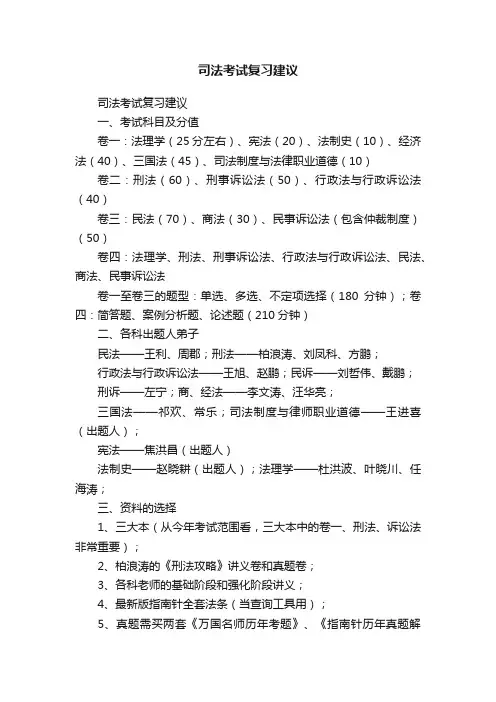
司法考试复习建议司法考试复习建议一、考试科目及分值卷一:法理学(25分左右)、宪法(20)、法制史(10)、经济法(40)、三国法(45)、司法制度与法律职业道德(10)卷二:刑法(60)、刑事诉讼法(50)、行政法与行政诉讼法(40)卷三:民法(70)、商法(30)、民事诉讼法(包含仲裁制度)(50)卷四:法理学、刑法、刑事诉讼法、行政法与行政诉讼法、民法、商法、民事诉讼法卷一至卷三的题型:单选、多选、不定项选择(180分钟);卷四:简答题、案例分析题、论述题(210分钟)二、各科出题人弟子民法——王利、周郡;刑法——柏浪涛、刘凤科、方鹏;行政法与行政诉讼法——王旭、赵鹏;民诉——刘哲伟、戴鹏;刑诉——左宁;商、经法——李文涛、汪华亮;三国法——祁欢、常乐;司法制度与律师职业道德——王进喜(出题人);宪法——焦洪昌(出题人)法制史——赵晓耕(出题人);法理学——杜洪波、叶晓川、任海涛;三、资料的选择1、三大本(从今年考试范围看,三大本中的卷一、刑法、诉讼法非常重要);2、柏浪涛的《刑法攻略》讲义卷和真题卷;3、各科老师的基础阶段和强化阶段讲义;4、最新版指南针全套法条(当查询工具用);5、真题需买两套《万国名师历年考题》、《指南针历年真题解析》;6、最新版的考试大纲(非常重要,背诵记忆阶段可以比照着大纲问题去讲义中查漏补缺);7、下载各科老师最后冲刺阶段的各科模拟题(这里先推荐刘凤科的刑法168题);8、最后下载几套分年的真题增强信心。
(记得关注考试大纲出版时间,早点买)四、复习规划第一阶段(3.1---3.30)先听基础班讲义(有些老师叫着先修班讲义,基础差寒假有空就可以听先修班)第二阶段(4.1---5.30)看2013年的三大本(三大本一定要认真看,不然听强化讲义知识点不系统整体,2014年出来后买增补版)和基础班讲义,一边做万国的分科真题(看一科,做一科的真题。
真题第一遍,可以只做客观题)第三阶段(6.1---7.30)听强化班讲义和做分科真题,包括主观题。
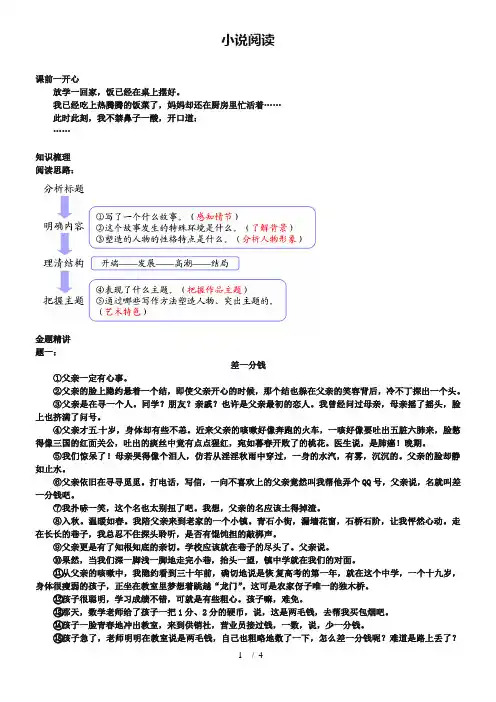
小说阅读课前一开心放学一回家,饭已经在桌上摆好。
我已经吃上热腾腾的饭菜了,妈妈却还在厨房里忙活着……此时此刻,我不禁鼻子一酸,开口道:……知识梳理阅读思路:金题精讲题一:差一分钱①父亲一定有心事。
②父亲的脸上隐约悬着一个结,即使父亲开心的时候,那个结也躲在父亲的笑容背后,冷不丁探出一个头。
③父亲是在寻一个人。
同学?朋友?亲戚?也许是父亲最初的恋人。
我曾经问过母亲,母亲摇了摇头,脸上也挤满了问号。
④父亲才五十岁,身体却有些不恙。
近来父亲的咳嗽好像奔跑的火车,一咳好像要吐出五脏六肺来,脸憋得像三国的红面关公,吐出的痰丝中竟有点点猩红,宛如暮春开败了的桃花。
医生说,是肺癌!晚期。
⑤我们惊呆了!母亲哭得像个泪人,仿若从淫淫秋雨中穿过,一身的水汽,有雾,沉沉的。
父亲的脸却静如止水。
⑥父亲依旧在寻寻觅觅。
打电话,写信,一向不喜欢上的父亲竟然叫我帮他弄个QQ号,父亲说,名就叫差一分钱吧。
⑦我扑哧一笑,这个名也太别扭了吧。
我想,父亲的名应该土得掉渣。
⑧入秋。
温暖如春。
我陪父亲来到老家的一个小镇。
青石小街,漏墙花窗,石桥石阶,让我怦然心动。
走在长长的巷子,我总忍不住探头聆听,是否有馄饨担的敲梆声。
⑨父亲更是有了知根知底的亲切。
学校应该就在巷子的尽头了。
父亲说。
⑩果然,当我们深一脚浅一脚地走完小巷,抬头一望,镇中学就在我们的对面。
⑪从父亲的咳嗽中,我隐约看到三十年前,确切地说是恢复高考的第一年,就在这个中学,一个十九岁,身体很瘦弱的孩子,正坐在教室里梦想着跳越“龙门”。
这可是农家伢子唯一的独木桥。
⑫孩子很聪明,学习成绩不错,可就是有些粗心。
孩子嘛,难免。
⑬那天,数学老师给了孩子一把1分、2分的硬币,说,这是两毛钱,去帮我买包烟吧。
⑭孩子一脸青春地冲出教室,来到供销社,营业员接过钱,一数,说,少一分钱。
⑮孩子急了,老师明明在教室说是两毛钱,自己也粗略地数了一下,怎么差一分钱呢?难道是路上丢了?不可能,自己用手紧紧捏着,生怕掉一分钱,短短的几百米,钱都捏出了一层浅浅的汗水。
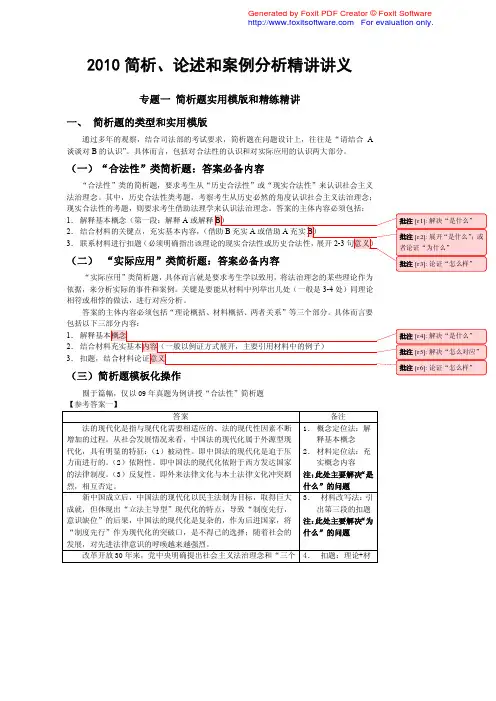
2010简析、论述和案例分析精讲讲义专题一 简析题实用模版和精练精讲一、 简析题的类型和实用模版通过多年的观察,结合司法部的考试要求,简析题在问题设计上,往往是“请结合A 谈谈对B 的认识”。
具体而言,包括对合法性的认识和对实际应用的认识两大部分。
(一) “合法性”类简析题:答案必备内容“合法性”类的简析题,要求考生从“历史合法性”或“现实合法性”来认识社会主义法治理念。
其中,历史合法性类考题,考察考生从历史必然的角度认识社会主义法治理念;1. 解释基本概念(第一段:解释A2. 结合材料的关键点,充实基本内容,3. 联系材料进行扣题(二) “实际应用”类简析题,具体而言就是要求考生学以致用,将法治理念的某些理论作为依据,来分析实际的事件和案例。
关键是要能从材料中列举出几处(一般是3-4处)同理论相符或相悖的做法,进行对应分析。
答案的主体内容必须包括“理论概括、材料概括、两者关系”等三个部分。
具体而言要1. 2. 3. (三) 简囿于篇幅,仅以09年真题为例讲授“合法性”简析题【参考答案一】答案备注 法的现代化是指与现代化需要相适应的、法的现代性因素不断增加的过程。
从社会发展情况来看,中国法的现代化属于外源型现代化,具有明显的特征:(1)被动性。
即中国法的现代化是迫于压力而进行的。
(2)依附性。
即中国法的现代化依附于西方发达国家的法律制度。
(3)反复性。
即外来法律文化与本土法律文化冲突剧烈,相互否定。
1. 概念定位法:解释基本概念 2. 材料定位法:充实概念内容 注:此处主要解决“是什么”的问题 新中国成立后,中国法的现代化以民主法制为目标,取得巨大成就,但体现出“立法主导型”现代化的特点,导致“制度先行,意识缺位”的后果,中国法的现代化是复杂的,作为后进国家,将“制度先行”作为现代化的突破口,是不得已的选择;随着社会的发展,对先进法律意识的呼唤越来越强烈。
3. 材料改写法:引出第三段的扣题 注:此处主要解决“为什么”的问题改革开放30年来,党中央明确提出社会主义法治理念和“三个4. 扣题:理论+材至上”,这属于法律思想体系的范畴,为社会主义初级阶段的社会主义现代化建设提供了理论指引和思想基础,利于处理法治现代化进程中出现的重大问题,是指导我国建设法治国家的思想观念体系,为社会主义民主法治指明了方向,具有重大的意义。
考点1:“依法执政、依法行政、依法治国共同推进,法治国家、法治政府、法治社会一体建设”——法律与国家、法律与社会、法律与政策的关系法律与社会:(1)社会是法律的前提和基础。
社会的性质决定了法律的性质,社会的变化与发展决定了法律的变化与发展。
(2)法律是社会运行的保障。
法律通过设定权利义务来规范人们的行为,从而实现对社会经济、政治以及文化的调控作用。
法律与国家:(1)法律赋予国家权力合法性,强化和维护国家权力;(2)法律对国家权力进行约束和限制。
现代法治的精义在于“控制国家权力”——只有接受法律的控制,国家权力在形式和实质层面才具有合法性。
法与执政党政策:(1)意志属性不同。
法律代表的是国家意志,执政党政策代表的是党的意志;(2)强制性不同。
法律靠国家强制力,政策依靠党内纪律;(3)稳定性不同。
法律强调稳定,政策则具有灵活性;(4)法律强调严格的逻辑结构,党的政策则具有多种形式。
但是,法律与执政党政策在经济基础、根本目标等方面具有一致性,建设社会主义法治国家,必须强调二者的衔接,共同发挥二者的作用。
考点2:推行改革措施的意义***措施具有重要意义:(1)这是坚持和发展中国特色社会主义的本质要求和重要保障;(2)这是实现国家治理体系和治理能力现代化的必然要求;(3)事关党执政兴国、事关人民幸福安康、事关党和国家的长治久安;(4)全面建成小康社会、实现中华民族伟大复兴、全面深化改革,必须全面推进依法治国。
考点3:依法治国的基本原则(1)坚持中国共产党的领导。
这是中国特色社会主义法治的最本质特征和最根本保证;(2)坚持人民主体地位。
人民是依法治国的主体和力量源泉,要以保障人民根本权益为法治的出发点和落脚点;(3)坚持法律面前人人平等。
要反对特权、反对歧视。
(4)坚持依法治国和以德治国相结合,发挥道德的滋养作用和法律的保障作用。
(5)坚持从中国实际出发。
中国特色社会主义道路、理论体系、制度是全面推进依法治国的根本遵循。
2018最新版杜洪波老师法理口诀[推荐五篇]第一篇:2018最新版杜洪波老师法理口诀最新版杜洪波老师法理口诀1.法的规范作用口诀:指引自己,评价别人,教育一般人,预测将来事,强制一小撮。
2.法律作用的局限性一、法律的制定、实施等受到人的因素的影响。
“徒法不足以自行”,立法者不一定能正确把握社会的法律需要,执法者或司法者不一定能正确理解法律规定。
二、法律以社会为基础,不可能超出社会发展的需要去“创造”社会。
在这个意义上,社会是法律的前提或基础,法律与社会发展具有一致性。
需要注意的是:法律与社会发展具有一致性,这是就整体而言的。
如果从微观层面看,法律则可能超前或滞后于社会的发展。
三、语言(说)表达的局限,即可能存在“词不达意”的情形。
因此,法律解释必然存在。
四、调整范围的局限,即调整的社会关系在范围和深度上是有限的。
一方面,有些社会关系法律不能调整,如纯粹的恋爱关系、日常生活中的好意施惠关系等,一般不属于法律的调整范围;另一方面,有些社会关系虽然归法律调整,但必须控制在一定程度内,如社会危害程度不大的行为,不宜一概归入刑法调整。
五、法律也会受到其他社会规范的制约。
法律尤其受到政策、道德、宗教等社会规范的影响和制约。
口诀:人会说犯规3.法律保留中的绝对不得授权事项1、犯罪和刑罚2、对公民政治权利的剥夺3、限制人身自由的强制措施和处罚4、司法制度口诀:证人死罪 4.市法规的立法范围城乡建设与管理、环境保护、历史文化保护等方面口诀:城建环保史个经批准1、区条例全常批2、州县条例省常批3、市法规省常批6.变通规定(民族、经特可变通)一、民族自治法规。
民族自治法规有权对法律和行政法规作出变通规定;但限制条件是:(1)不得对宪法和民族区域自治法作变通;(2)不得违背法律或行政法规基本原则;(3)不得对有关法律、行政法规专门就民族自治地方所作的规定作变通。
口诀:宪专基二、经济特区法规。
经济特区所在地的省、市人大及其常委会,根据全国人大的授权,制定经济特区法规,在经济特区范围内实施。
我的司考心得让信心和决心伴随整个温习进程成绩发布已经十天了,很庆幸自己今年能通过,所以我想,我应该先……感激国家!趁着对那段备考日子还有点印象,写点心得,其实就是流水账,虽然成绩不高,不过就算是一次总结吧,也是给某个明年考的同窗一点参考。
一样的,作为个人的经验,不必然适应所有人,我自己是大三在校生,有充沛的时间精力温习,基础差(大学什么样谁上谁知道。
我年年学分绩点排名年级倒数),有信心有决心通过,这是我自己的情况。
大家参考就是了,关于如何对待他人的经验,下面还会有涉及。
一、关于司法考试在你决定参加这场考试前,你得先了解一些关于司考的常识。
我自己在开始准备温习前,花了可能有一周的时间来研究这些东西,包括试卷组成,考试方式,资料选择,老师选择,温习方式,温习经验和往年资料的搜集。
这篇文章会尽可能涉及到这些方面,如有不足,请直接在学法网找。
首先讲下各卷的组成部份。
卷一包括社会主义法治理念、法理学、宪法、法制史、经济法、国际经济法、国际公法、国际私法、司法制度和法律职业道德。
题型包括单选题五十分五十道,多选题八十分四十道,不定项选择题二十分十道。
卷二包括刑法、刑事诉讼法、行政法与行政诉讼法。
题型同卷一。
卷三包括民法、民事诉讼法、商法。
题型同卷一。
卷四包括社会主义法治理念(必有)、法理学、刑法(必有)、民法(必有)、刑事诉讼法(必有)、民事诉讼法(必有)、行政法与行政诉讼法、商法。
其中不必然包括以上所列全数科目。
题型为主观题七道左右。
还有我感觉很重要的是,如何对待他人的温习经验。
网上的(插入广告:温习进程最常去的网站是学法网)温习经验一大堆,各式各样的,什么在校法本温习一(二、三、四……N)个月轻松过司考、在职考生司考温习辛酸泪、八年抗战最终胜利、司考没什么恐怖的我根本就是裸考就过了你们这群二逼还说什么天下第一考,等等。
你会发现有些很成心思,而且通过这些文章你恍如可以看出作者的为人……我已经把在学法网看他人的司考温习经验当做温习进程中一个很好消遣了(并无贬低的意思),即便我考完了,成绩出来了,我还会偶尔看看。
杜洪波法理“三言”,通杀卷一卷四的得分神器!第一言世界是相对的世界即:绝对判断一般是错误判断。
即出现“只要……就;任何……;都是……;总是……”等等字眼的选项,一般是错误的;同理,出现“一定程度”、“不完全”、“之一”等相对性词汇,则往往是正确的。
1.法律格言说:“不知自己之权利,即不知法律。
”关于这句法律格言涵义的阐释,下列哪一选项正确?A.不知道法律的人不享有权利B.任何人只要知道自己的权利,就等于知道整个法律体系C.权利人所拥有的权利,既是事实问题也是法律问题D.权利构成法律上所规定的一切内容,在此意义上,权利即法律,法律亦权利2.法律格言说:“紧急时无法律。
”关于这句格言涵义的阐释,下列哪一选项是正确的?A.在紧急状态下是不存在法律的B.人们在紧急状态下采取紧急避险行为可以不受法律处罚C.有法律,就不会有紧急状态D.任何时候,法律都以紧急状态作为产生和发展的根本条件3.奥地利法学家埃利希在《法社会学原理》中指出:“在当代以及任何其他的时代,法的发展的重心既不在立法,也不在法学或司法判决,而在于社会本身。
”关于这句话涵义的阐释,下列哪一选项是错误的?A.法是社会的产物,也是时代的产物B.国家的法以社会的法为基础C.法的变迁受社会发展进程的影响D.任何时代,法只要以社会为基础,就可以脱离立法、法学和司法判决而独立发展第二言世界是对立统一的世界即,完全割裂或完全等同的判断,一般是错误判断。
即出现“A 就是B,A与B完全、A与B无关”等字眼的选项,一般是错误的。
同理,A与B“既区别又联系”之类的说法,则必然是正确的。
因此,其他诸如“兼顾、协调、循环”等词汇,往往是正确答案。
既然万物之间都具有“对立统一性”,因此,在设计选项时,如果想让该选项错误,则必须表述的非常明确、甚至非常极端,因此,由此也衍生出一个规律:中性词汇不命题1.法律解释是法律适用中的必经环节。
关于法律解释及其方法,下列哪一说法是错误的?A.“欲寻词句义,应观上下文”,描述的是体系解释方法B.文义解释是首先考虑的解释方法,相对于其他解释方法具有优先性C.历史解释的对象主要是法律问题中的历史事实,与特定解决方案中的法律后果无关D.客观目的解释中,一些法伦理性的原则可以作为解释的根据2.关于法律解释和法律推理,下列哪一说法可以成立?A.作为一种法律思维活动,法律推理的根本目的在于发现绝对事实和真相B.法律解释和法律推理属于完全不同的两种思维活动,法律推理完全独立于法律解释C.法官在进行法律推理时,既要遵守和服从法律规则又要在不同利益冲突间进行价值平衡和选择D.法律推理是严格的形式推理,不受人的价值观影响第三言世界是多维的世界世界上一般不存在一因一果的关系。